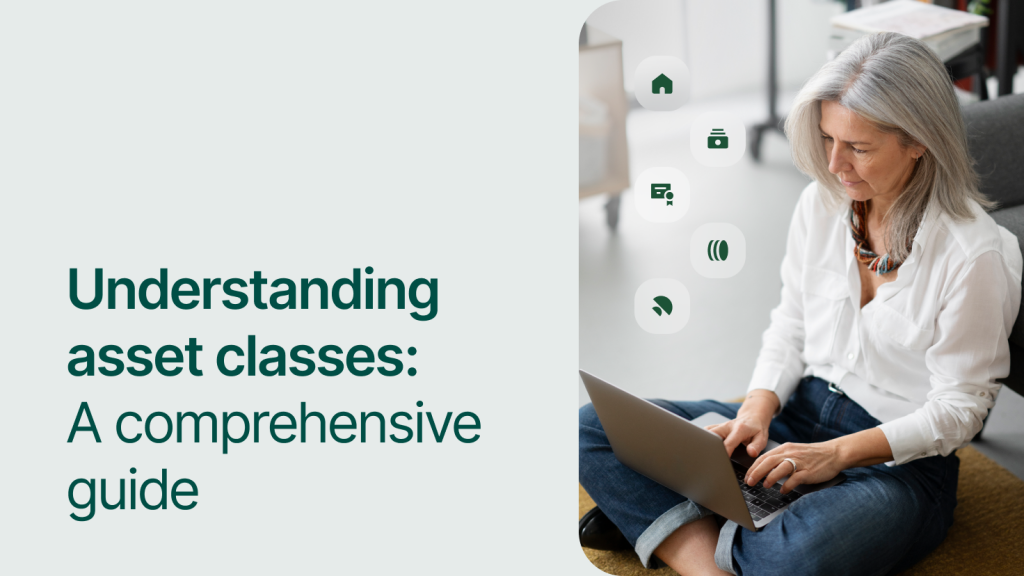Understanding asset classes helps in making informed investment decisions. Asset classes are groups of investments that behave similarly in the market, sharing common characteristics, risk factors, and potential returns. Knowing how different types of asset classes work allows investors to manage risks effectively and diversify their portfolios to meet their financial goals.
In recent years, alternative asset classes have gained traction, challenging traditional options and offering investors a broader spectrum of opportunities. However, it remains important that investors can achieve their return expectations while taking on a level of risk that they’re comfortable with. So understanding the varying risks and returns of each asset class can be key to achieving investment goals.
As we approach 2024, understanding major asset classes and comparing them in terms of asset class returns and asset class performance is vital. Investors should align their return expectations with their risk management strategies.
This guide explores the risks and returns of various asset classes including the equity asset class (stocks), the real estate asset class, the fixed income asset classes (bonds), and loans. With this knowledge, you can better align your investments with your risk tolerance and long-term goals.
What are asset classes?
Asset classes are groups of financial instruments that exhibit similar characteristics, behave similarly in the marketplace, and are subject to the same laws and regulations. These classes include traditional assets like stocks (equities), bonds, and real estate, as well as alternative asset classes such as cryptocurrencies and loans.
The major asset classes, explained
Stocks (Equities)
Stocks (or equities) are among the oldest and most widely regarded major asset classes in the investment market. They’re an integral part of economies in developed and developing countries and are responsible for a vast amount of the world’s wealth creation.
Often traded via stock exchanges, stocks are considered a core equity asset class. They are relatively low maintenance and can generate returns much higher than other traditional asset classes. Several factors influence asset class performance for stock:
- Economic factors: Events like financial crises, political instability, or pandemics can impact stock prices globally.
- Regulatory and legislative factors: Economic policies and regulatory changes can affect the operations and profitability of companies, influencing stock prices.
- Inflation and interest rates: These can strengthen or weaken economies, thereby influencing stock prices.
- Analyst ratings: Predictions about a stock’s future performance can significantly influence investor sentiment and stock prices.
Stocks continue to be a go-to asset class because of its ability to generate attractive returns – especially for those with long-term investment goals.
Real estate
We need real estate to live and work, and because of this, the real estate asset class is one that most, if not all, investors are familiar with. Real estate investments are illiquid (not easily converted to cash) because the acquisition process is often expensive and time-consuming. However, these investments can produce rental income (returns) for many years, generating long-term wealth for investors. As well as this, a property’s value can grow significantly over time (capital gains), which further increases the attractiveness of this asset class for many.
Real estate is a tangible asset class that involves the ownership, management, and rental or sale of land and buildings. Unlike equity asset classes, real estate investments are illiquid, meaning they cannot be easily converted to cash. However, they offer long-term wealth-building potential through rental income and capital appreciation.
Passive real estate investing on platforms like Mintos allows you to invest in rental residential real estate with minimal effort. This strategy suits those looking for a hands-off approach to earning regular income from rent without dealing with the day-to-day management of properties.
Factors influencing real estate returns include:
- Market factors: Global financial markets can affect real estate values. For example, during the 2009 Global Financial Crisis, real estate values plummeted, leading to massive investment losses.
- Local market dynamics: Changes in supply and demand for properties in local markets can impact rental income and property valuations. This highlights the importance of asset classes and diversification within real estate to manage regional risks effectively.
- Regulatory factors: Building codes, zoning laws, and environmental regulations can make property ownership more expensive or less desirable, influencing overall asset class performance. These considerations are essential for those evaluating the best asset classes for investment.
- Physical and operational factors: Properties require ongoing maintenance and management, which can affect asset class returns. Poorly managed properties may see a decline in value, emphasizing the need for careful management within the real estate asset class.
Bonds
Bonds form a part of many traditional portfolios as they’re mostly low-risk and provide an easy way for investors to earn a passive income. In addition, adding bonds to an investment portfolio can decrease its overall volatility, especially if your portfolio includes stocks.
To measure the quality of bonds, they’re given ratings, which represent the risk of the bond issuer (the borrower). AAA-rated bonds, for example, are almost risk-free, whereas CCC to D-rated bonds come with much higher levels of risk.
Bonds are a fixed-income asset class that represents a loan made by an investor to a borrower, typically a corporation or government. Bonds are considered lower risk compared to stocks, providing a reliable source of passive income. Including bonds in an investment portfolio can help reduce overall volatility, especially when combined with more volatile assets like stocks.
Types of bonds
- Government bonds: Issued by governments to finance their activities, these bonds are seen as low-risk investments, particularly in stable, developed countries. However, in recent years, returns from government bonds have been declining, with rising inflation rates outpacing bond yields. In some previous cases, government bond returns have even turned negative, impacting the asset class returns of this fixed-income asset class.
- Corporate bonds: Issued by businesses, corporate bonds usually offer higher returns than government bonds due to their higher risk. Corporate bonds are influenced more by local market factors than global ones and are subject to default risk, affecting asset class performance.
- High-yield (junk) bonds: These bonds are rated below investment grade and offer higher returns due to the increased risk of default. High-yield bonds are illiquid and less transparent, making them a riskier investment. Investors often purchase these bonds with the hope that their rating will eventually improve to investment grade, which would enhance their asset class returns.
- Fractional bonds: This makes investing accessible by allowing retail investors to buy small portions of a bond, starting from just €50 on Mintos. Unlike traditional bonds that require high minimum investments, these bonds enable the construction of a diversified bond portfolio with a lower entry point.
Factors influencing bond returns
Several factors impact bond returns across all types:
- Repayment: The borrower may fail to make timely repayments, impacting returns.
- Inflation rate: Rising inflation can erode the real value of bond returns over time.
- Interest rates: Bond prices are inversely related to interest rates. When interest rates rise, the fixed rates offered by bonds become less attractive, causing bond prices to fall.
- Investor perception: Negative perceptions of the bond issuer can lead to declines in bond prices.
Despite the declining yields, bonds remain a core component of a diversified investment portfolio, especially for those seeking stability and steady income.
Loans
Loans are an alternative asset class that has gained popularity among investors looking for a stable income stream. Traditionally, the loan investment market was dominated by banks and large institutions, but technology has opened up opportunities for retail investors to participate in this space.
Platforms like Mintos have made it easier to invest in loans, offering expected repayment structures and fixed interest rates, which provide a straightforward way to earn passive income. This makes loans one of the best asset classes for investment for those looking to diversify their portfolios beyond traditional options.
Factors influencing loan investment returns
Several factors can affect the returns on loan investments:
- Loan-specific: Borrowers may fail to make scheduled repayments or may repay their loans early, leading to lower returns.
- Lending company risks: If a lending company goes out of business or faces financial difficulties, it may fail to meet its contractual obligations, such as buyback guarantees or payments. This is a key consideration for investors focusing on asset classes and risk management. The financial health of the lending company also plays a crucial role in ensuring that repayments are made to investors, affecting the overall asset class performance.
- Regulatory and compliance risks: Loan platforms and lending companies are subject to various regulations that can change over time. Regulatory changes can impact the business operations of these companies and, consequently, investor returns, emphasizing the importance of understanding asset classes and diversification when investing in loans.
Asset classes and risk management
Navigating the relationship between asset classes and risk is key to building a resilient portfolio. Different types of asset classes carry varying levels of risk, so aligning your choices with your risk tolerance is crucial. Stocks, for instance, offer higher returns but come with greater volatility, while bonds provide more stability with lower returns.
For those new to investing, starting with a diverse mix of major asset classes can strike a balance between risk and reward. As experience grows, exploring alternative asset classes can add new dimensions to your portfolio and enhance returns.
Asset classes and portfolio diversification
Asset classes and diversification work together to optimize your investment strategy. By spreading investments across different asset classes, you can reduce the impact of any single underperforming category. A well-rounded portfolio typically includes a mix of equity asset classes, fixed income asset classes, and alternative asset classes.
For beginners, starting with a diversified selection of major asset classes helps minimize risk while offering growth potential. Looking ahead to 2024, integrating newer alternative asset classes can further strengthen your portfolio and enhance risk management.
- Example: Imagine you have a portfolio consisting only of stocks. If the stock market experiences a downturn, your entire portfolio could suffer significant losses. However, by diversifying into bonds and real estate (which may perform differently in the same market conditions), you reduce the risk of losing a large portion of your investment at once. For instance, while stocks might be volatile during an economic slowdown, bonds may provide steady returns, and real estate can offer income through rent.
Bringing it all together: How to choose asset classes
Each asset class—whether it’s stocks, bonds, real estate, loans, or cryptocurrencies—plays a unique role in shaping a balanced investment portfolio. By diversifying across these asset classes, you can better navigate market volatility and tailor your investments to fit your risk tolerance and financial goals.
Selecting the right mix of asset classes is key to managing risk and maximizing returns. As you consider your next investment moves, keep in mind the distinctive characteristics, risks, and potential returns of each class. Your understanding of these differences will guide you in building a portfolio that aligns with your vision for the future.
For more insights on optimizing your investment strategy, check out our articles on strategic asset allocation and long-term investments.
Disclaimer:
This is a marketing communication and in no way should be viewed as investment research, investment advice, or recommendation to invest. The value of your investment can go up as well as down. Past performance of financial instruments does not guarantee future returns. Investing in financial instruments involves risk; before investing, consider your knowledge, experience, financial situation, and investment objectives

